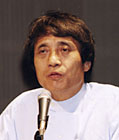 Keynote Address 2
Keynote Address 2
"Considering Asia Through the Seto Inland Sea"

- Tadao Ando
-
- Architect/Professor, Graduate School of Engineering, Tokyo University
Professor Tadao Ando was born in 1941 in Osaka. He studied architecture independently before establishing the Ando Tadao Architectural Research Institute in 1969. In 1979 he won the Prize of the Architectural Institute of Japan for his "Sumiyoshi row house or Azuma House." Subsequently in 1995 he won a number of domestic and international prizes such as the Asahi Prize and the Pritzker Architecture Prize. He currently works as an architect and as a professor at the University of Tokyo. He is active in his efforts to support the reconstruction of the areas hit by the Great Hanshin-Awaji Earthquake as the chairperson of the Ten Year Reconstruction Assistance Committee.
It has been, in the fifty years since the 1950s, of the post-war period that the Japanese have come to completely discard the sense of values that place importance on maintaining and preserving things, social awareness, and sympathy for others. These have now been replaced by the path to greed and materialism. The urban sprawl we see today in Japan are the result of the continued pursuit of a luxurious lifestyle. Mass production and mass consumption have brought us to an impasse. We are now required to undergo a massive change in attitude.
The time has now come that we should begin to consider "green." In the throwaway society in which we live, green can be indispensable since it can teach us a great deal in our daily lives, such as respect for other living things.
As an architect, I believe one of the social aspects of my job is a responsibility to the environment. It is not merely a job that involves creating buildings, but one that involves the continuous design of structures that take into account natural surroundings, regional society, with the aim of improving the environment in which the sites are located. In my case, in the Kansai area, which is the focus of my activities, almost all of my work is concentrated around the Seto Inland Sea, Osaka Bay, and the areas further inland. Through each work, I am to somehow contribute to urban development.
As for the environmental concerns, I have been involved in afforestation, which I believe should be a part of an architects work. Given such opportunities provided by the Great Hanshin-Awaji Earthquake, such efforts as the Hyogo Green Network, which aims to plant trees which bloom with white flowers in the disaster area, and the Setouchi Olive Foundation, which aims to plant one million trees in the islands of the Seto Inland Sea, were begun in 2001. Although such activities will take time, there has been a lot of support by many people and hopefully this will continue. I believe it is worth the struggle to continue even with the considerable difficulties that lie ahead.
In the Setouchi Olive Foundation, in addition to planting trees, a number of ideas have been attempted, such as the Dongri (Acorn) Project, in which elementary school children from the region collect and plant acorns, or planting a cherry tree to commemorate entering elementary school. It is expected that "green" rejuvenate the regional community.
In the end, the only way to improve the environment is change our way of thinking. The activities around the Seto Inland Sea are small, but I hope that this small step will develop into something great and inspire the rest of Asia.






